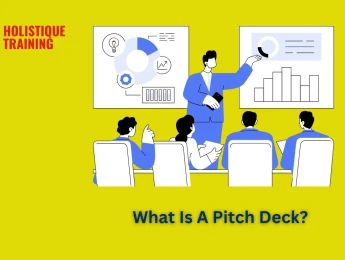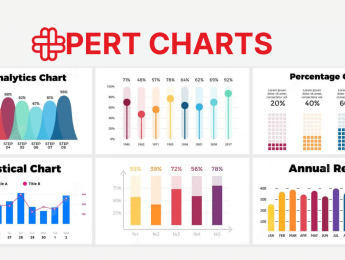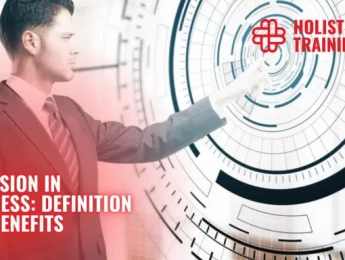- Table of Contents
- Introduction
- What Is a Pitch Deck?
- The Different Types of Pitch Decks
- 1. Startup Pitch Deck
- 2. Sales Pitch Deck
- 3. Investor Pitch Deck
- 4. Partnership Pitch Deck
- Who Needs a Pitch Deck?
- Startups and Entrepreneurs
- Small and Medium-sized Enterprises (SMEs)
- Sales and Marketing Teams
- Non-profit Organisations
- Steps to Create a Pitch Deck
- 1. Define Your Objective
- 2. Research Your Audience
- 3. Craft a Compelling Story
- 4. Start with a Strong Hook
- 5. Present Your Unique Selling Points
- 6. Market Analysis and Opportunity
- 7. Business Model and Revenue Streams
- 8. Showcase Your Team
- 9. Financial Projections
- 10. Visuals and Design
- 11. Keep it Concise and Focused
- 12. Practice, Practice, Practice
- Emerging Trends in Pitch Deck Design
- 1. Interactive Elements
- 2. Virtual Reality (VR) Presentations
- 3. Minimalistic Design with Maximal Impact
- 4. Data Visualisation Mastery
- 5. Story-Driven Animations
- 6. Inclusive Design for Accessibility
- 7. Personalised and Adaptive Content
- 8. Blockchain for Security and Transparency
- Conclusion
Introduction
Effective communication is paramount in the world of entrepreneurship and business. A well-crafted pitch deck can be the key to success when seeking investors, partners, or clients. A pitch deck is a powerful visual presentation that encapsulates the essence of a business idea, product, or project, captivating the audience and leaving a lasting impression. In this comprehensive guide, we will explore the significance of pitch decks, their various types, and the step-by-step process for creating one that stands out from the crowd.
What Is a Pitch Deck?
A pitch deck is a structured and visually engaging presentation that conveys the core elements of a business concept. Typically consisting of 10 to 20 slides, it aims to capture the attention of potential investors, partners, or clients and inspire them to take action. An effective pitch deck highlights the unique selling points of the idea or product and outlines the market opportunity, showcasing the potential for growth and profitability.
The Different Types of Pitch Decks
1. Startup Pitch Deck
The startup pitch deck is not just a funding request; it's a narrative that paints a vivid picture of a problem in the market and how the startup is uniquely positioned to solve it. This type of pitch deck often begins with a compelling story, introducing the audience to the pain points experienced by potential customers. It then seamlessly transitions into the proposed solution, emphasising innovation and market disruption. A crucial element of the startup pitch deck is the team slide, where the founders' expertise and passion are showcased to instil confidence in potential investors.
Slide | Content |
1 | Introduction and Problem Statement |
2 | Solution and Unique Value Proposition |
3 | Market Potential and Opportunity |
4 | Business Model |
5 | Team Introduction |
Table 1: Startup pitch deck components
2. Sales Pitch Deck
Sales pitch decks are dynamic presentations crafted to resonate with potential clients personally and professionally. These decks go beyond merely showcasing features; they create an emotional connection between the audience and the product or service. The emphasis is on demonstrating what the offering does and how it addresses the client's specific needs and challenges. Visual elements play a pivotal role in sales pitch decks, using images and infographics to simplify complex concepts and drive home the product or service's benefits.
3. Investor Pitch Deck
The investor pitch deck is a detailed financial roadmap for companies eyeing substantial investments from institutional investors or private equity firms. This type of presentation delves deep into the numbers, providing comprehensive insights into the business's financial health and growth trajectory. Investor pitch decks often feature detailed financial projections, including revenue forecasts, expenses, and break-even analysis. The emphasis here is on demonstrating the potential for profitability and the calculated risks associated with the investment.
4. Partnership Pitch Deck
In the realm of strategic collaborations, the partnership pitch deck takes centre stage. This presentation is all about synergy and mutual benefits. It outlines how a partnership can create a win-win scenario for both parties involved, emphasising shared goals and complementary strengths. Unlike other pitch decks, partnership pitches often showcase not only the business case but also the cultural alignment and potential long-term value of the collaboration. Visuals in this type of pitch deck may include graphics representing the interconnectedness and mutual growth envisioned through the partnership.
Each type of pitch deck serves a distinct purpose and requires a tailored approach to communicate its intended message effectively. Whether it's sparking the interest of venture capitalists, winning over clients, securing substantial investments, or fostering strategic partnerships, understanding the nuances of each pitch deck type is essential for success in the competitive landscape of business and entrepreneurship.
Who Needs a Pitch Deck?
Pitch decks are not solely the domain of startups for entrepreneurs seeking funding. Any individual or company with a compelling idea, product, or project can benefit from a well-crafted pitch deck. Here are some scenarios where pitch decks are invaluable:
Startups and Entrepreneurs
For startups and entrepreneurs, pitch decks are akin to a gateway, opening doors to crucial funding opportunities. These presentations serve as a visual manifesto, succinctly encapsulating the essence of a business idea. Beyond financial backing, pitch decks for startups establish credibility and trust among potential investors. They showcase not just the venture's viability but also the founders' passion and expertise, setting the stage for a successful partnership.
Small and Medium-sized Enterprises (SMEs)
SMEs often find themselves at pivotal junctures where expansion or the launch of a new product requires additional financial support. In such scenarios, pitch decks become a compelling instrument for attracting potential investors or strategic partners. These presentations enable SMEs to articulate their growth plans, demonstrate market potential, and highlight the tangible benefits that collaboration or investment can bring. A well-structured pitch deck for SMEs is not just a document; it's a strategic tool for business development.
Sales and Marketing Teams
Pitch decks are not exclusive to seeking external support; they are equally potent for internal teams, especially in sales and marketing. Sales pitch decks, in particular, act as dynamic tools for engaging potential clients. Sales teams leverage these presentations during client meetings, conferences, or virtual presentations to convey the value proposition of their products or services. A compelling sales pitch deck is more than a sales aid; it's a persuasive narrative that guides potential clients through the journey of understanding and embracing what the company offers.
Non-profit Organisations
In the realm of non-profit organisations, pitch decks take on a slightly different but equally crucial role. These presentations convey the organisation's mission, goals, and impact to potential donors and supporters. Non-profit pitch decks aim to evoke emotions, align values, and establish a connection with the audience. Through compelling visuals and a well-crafted narrative, these decks inspire financial contributions and foster collaboration, essential for the sustained success of non-profit initiatives.
Pitch decks are a versatile communication tool that transcends industry boundaries. They are indispensable for anyone or any entity with a compelling idea, product, or project. Whether you're a startup seeking seed funding, an SME aiming for expansion, a sales team pursuing clients, or a non-profit organisation rallying support, a meticulously crafted pitch deck can be the catalyst for achieving your objectives. It's not just a presentation; it's a strategic asset that can elevate your message and leave a lasting impression on your target audience.
Steps to Create a Pitch Deck
Crafting an impactful pitch deck is a systematic process that involves a strategic blend of creativity, research, and storytelling. The following steps outline a comprehensive guide to help you create a pitch deck that captivates your audience and achieves your objectives:
1. Define Your Objective
Before diving into the creation process, clarity on your objective is paramount. Are you seeking funding, attracting clients, forming partnerships, or showcasing your product? Each objective requires a tailored approach in both content and structure. Clearly defining your goal will serve as the guiding force throughout the pitch deck creation journey.
2. Research Your Audience
Tailoring your pitch deck to resonate with your specific audience is key to its success. Conduct thorough research to understand your target audience's interests, pain points, and priorities. This insight will enable you to customise your messaging, ensuring that your pitch addresses the needs and concerns of those you are trying to engage.
3. Craft a Compelling Story
Storytelling is a powerful tool to captivate the audience. According to research conducted at Stanford University, as mentioned by Slide Model, incorporating stories into presentations enhances retention as compared to conveying simple facts. Stories profoundly impact memory, making them a powerful tool for effective communication. So, make sure you create a narrative that connects with the audience emotionally while highlighting the value proposition of your idea or product.
4. Start with a Strong Hook
The initial slides of your pitch deck serve as the first impression. Hook your audience from the outset with an attention-grabbing opening. Clearly articulate the problem your idea or product addresses, creating a sense of urgency. A strong hook sets the tone for the entire presentation, ensuring that your audience is invested from the beginning.
5. Present Your Unique Selling Points
Clearly outlining your unique selling points is crucial for differentiating yourself from competitors. This section should highlight your idea or product's distinct features and advantages. Communicate why your solution is unparalleled and showcase the strengths that position you as a formidable player in the market. This is your opportunity to shine and leave a lasting impression.
6. Market Analysis and Opportunity
A comprehensive market analysis is the backbone of your pitch deck. Demonstrate the potential demand for your product or service and elucidate the market size you intend to target. Highlight market opportunities and trends that support your business case. This section provides a context for your venture, substantiating the need for your solution in the current market landscape.
7. Business Model and Revenue Streams
Clearly explain your business model, elucidating how you plan to generate revenue. Outline the scalability and profitability potential of your venture. Investors and stakeholders are keenly interested in understanding the financial viability of your business. Provide insights into your revenue streams, cost structure, and any unique monetisation strategies.
8. Showcase Your Team
Introduce your team members, emphasising their expertise and relevance to the success of your venture. Investors not only invest in ideas but also in the people behind them. Highlight the skills and experience of your team, showcasing why they are the right individuals to execute the proposed idea successfully. This adds a layer of credibility and trust to your pitch.
9. Financial Projections
Provide realistic and data-backed financial projections that offer a glimpse into the growth potential of your venture. This section should include revenue forecasts, projected expenses, and break-even points. Transparent and well-supported financial projections instil confidence in investors, assuring them of the calculated risks and potential returns associated with your business.
10. Visuals and Design
The visual appeal of your pitch deck is crucial for retaining audience attention. Utilise charts, graphs, images, and concise bullet points to convey information effectively. Visual elements should complement your narrative, making complex information easily digestible. Strive for a cohesive design that reflects the professionalism and creativity of your venture.
11. Keep it Concise and Focused
Avoid overwhelming your audience with excessive information. Keep the content concise, focusing on key elements that align with your objective. A clutter-free presentation allows your audience to absorb and retain information effectively. Each slide should contribute to the overall narrative, maintaining a sense of coherence throughout the pitch deck.
12. Practice, Practice, Practice
Rehearse your pitch thoroughly to deliver it confidently and fluently during the presentation. Practice helps refine your delivery, ensuring that you cover key points seamlessly and respond effectively to potential questions. Familiarity with your pitch deck enhances your ability to connect with the audience, instilling confidence in your message and vision. According to Inc., when preparing for a typical business or sales presentation lasting 20-45 minutes, aim to practise each slide comprehensively, from beginning to end, at least 10 times.
In short, the steps outlined above provide a roadmap for creating a pitch deck that captures attention and resonates with your audience. By defining your objective, researching your audience, crafting a compelling story, and following through with a well-structured and visually appealing presentation, you can maximise the impact of your pitch deck and increase the likelihood of achieving your desired outcomes.
Emerging Trends in Pitch Deck Design
As the business landscape evolves, so too does the art of pitch deck design. Staying abreast of emerging trends is crucial for ensuring your presentation remains contemporary and impactful. Let’s explore the latest trends shaping the world of pitch deck design, from innovative technologies to design aesthetics:
1. Interactive Elements
The integration of interactive elements is gaining prominence in pitch deck design. Rather than a static presentation, incorporating interactive features can elevate engagement and leave a lasting impression. Imagine a pitch where investors can interact with dynamic charts, explore product prototypes virtually, or participate in a live Q&A session within the presentation. This trend showcases technological prowess and actively involves the audience, fostering a more immersive and memorable experience.
2. Virtual Reality (VR) Presentations
Virtual reality (VR) presentations are making waves in the pitch deck arena in an era where virtual interactions have become the norm. VR technology enables presenters to create immersive environments, transporting the audience to a virtual boardroom, a product demonstration space, or even a simulated market scenario. This trend adds a futuristic flair to your pitch and enhances the visual storytelling aspect, making your presentation more engaging and memorable.
3. Minimalistic Design with Maximal Impact
While content remains king, design aesthetics are also shifting towards minimalism. A clean and uncluttered design allows the audience to focus on the core message without distractions. The minimalistic design doesn't mean sacrificing creativity; rather, it emphasises impactful visuals, strategic use of white space, and a cohesive colour palette. This trend reflects a commitment to clarity and simplicity, ensuring that each element in the presentation serves a purpose.
4. Data Visualisation Mastery
With the increasing importance of data-driven decision-making, mastering the art of data visualisation is a trend that continues to gain momentum. Complex data sets can be transformed into clear and compelling visuals, such as interactive charts, graphs, and infographics. Effectively conveying data enhances understanding and demonstrates a commitment to transparency and precision. This trend is particularly relevant for investor pitch decks, where numerical insights are pivotal.
5. Story-Driven Animations
Animations are evolving from mere embellishments to powerful storytelling tools. Strategic use of animations can guide the audience through the narrative, emphasising key points and creating a dynamic flow. From subtle transitions between slides to animated infographics that unfold sequentially, incorporating story-driven animations adds a layer of sophistication to your pitch deck. The goal is to enhance comprehension and engagement without overshadowing the core message.
6. Inclusive Design for Accessibility
As awareness of accessibility grows, pitch deck designers are embracing inclusive design principles. This involves creating presentations that are accessible to individuals with diverse abilities. From ensuring compatibility with screen readers to choosing colour schemes that cater to those with colour blindness, inclusive design broadens your audience reach. It reflects a commitment to diversity and equity.
7. Personalised and Adaptive Content
Tailoring content based on audience interactions is an emerging trend that adds a personalised touch to pitch decks. Imagine a presentation that adapts its content based on the specific interests or questions raised by the audience during a live session. This level of personalisation showcases adaptability and demonstrates a deep understanding of your audience's needs, creating a more meaningful and customised experience.
8. Blockchain for Security and Transparency
In an age where data security and transparency are paramount, the integration of blockchain technology into pitch decks is gaining attention. Blockchain ensures the integrity and security of data, offering a level of transparency that resonates well with investors. Whether it's showcasing the authenticity of financial data or providing a verifiable track record of achievements, leveraging blockchain adds an extra layer of credibility to your pitch.
In the ever-evolving landscape of pitch deck design, staying ahead of emerging trends is a strategic advantage. The possibilities for innovation are vast, from interactive elements and virtual reality presentations to minimalistic design and blockchain integration. While embracing these trends, it's essential to balance cutting-edge elements and the fundamental principles of effective communication. By staying informed and creatively adapting to new trends, your pitch deck can capture attention and set the standard for impactful and memorable presentations.
Conclusion
In conclusion, a pitch deck is an indispensable tool for businesses and entrepreneurs seeking to make a lasting impact on their audience. By crafting a compelling narrative, showcasing unique selling points, and providing data-backed insights, you can create a pitch deck that captures attention, generates interest, and increases the chances of success.
Remember, a well-designed pitch deck is about what you say and how you say it. Embrace the art of storytelling, and let your passion and vision shine through your presentation. To do so, you will need to have exceptional presentation skills. That’s where we come in! We’ve got the perfect course for you, ‘Advanced Presentation Skills’, designed especially for any professional wishing to master their presentation skills. Enrol now and start achieving your business goals and leaving a lasting impression in the minds of your audience.
























